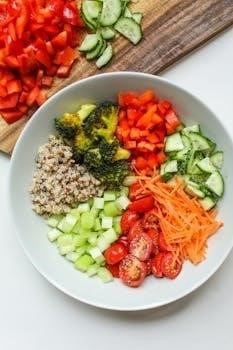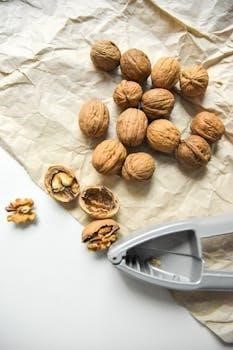Candida Diet Food List PDF⁚ A Comprehensive Guide
Embark on a journey to wellness with our comprehensive Candida Diet Food List PDF. This guide provides essential information on managing Candida overgrowth through diet.
The Candida diet is designed to combat Candida overgrowth‚ a condition where the Candida fungus multiplies excessively in the body‚ leading to various health issues. This dietary approach focuses on eliminating foods that feed Candida and promoting foods that support a healthy gut. The goal is to reduce inflammation‚ restore balance‚ and alleviate symptoms associated with Candida overgrowth.
Understanding the principles of the Candida diet is crucial for success. It involves restricting sugars‚ refined carbohydrates‚ and processed foods‚ which can fuel Candida growth. Instead‚ the diet emphasizes non-starchy vegetables‚ lean proteins‚ and healthy fats.
Following the Candida diet requires commitment and careful planning‚ but it can be an effective way to manage Candida overgrowth and improve overall well-being. This guide will provide you with a detailed Candida Diet Food List PDF to help you navigate this dietary journey effectively.
Understanding Candida Overgrowth
Candida overgrowth occurs when the Candida fungus‚ naturally present in the body‚ proliferates excessively. This imbalance can lead to various health problems‚ impacting the digestive system and overall well-being.
Symptoms of Candida Overgrowth
Candida overgrowth manifests through a range of symptoms‚ often affecting different parts of the body. Digestive issues are common‚ including bloating‚ gas‚ constipation‚ or diarrhea. Fatigue and persistent tiredness‚ even after adequate rest‚ are also frequently reported. Brain fog‚ characterized by difficulty concentrating and memory problems‚ can significantly impact daily life.
Skin problems such as rashes‚ eczema‚ and fungal infections like athlete’s foot or nail fungus may also indicate Candida overgrowth. Furthermore‚ recurring yeast infections in women and oral thrush (white coating on the tongue) are telltale signs. Joint pain‚ allergies‚ and mood swings can also be linked to Candida.
It’s important to consult a healthcare professional for proper diagnosis‚ as these symptoms can overlap with other conditions. Addressing Candida overgrowth often involves dietary changes and antifungal treatments to restore balance in the body. Recognizing these symptoms is the first step towards effective management.
The Role of Diet in Managing Candida
Diet plays a crucial role in managing Candida overgrowth by controlling its food source⁚ sugar. Candida thrives on sugars and simple carbohydrates‚ so reducing their intake is fundamental. A diet high in sugar promotes Candida growth‚ leading to various health issues.
The Candida diet aims to starve the yeast by eliminating these fuel sources‚ shifting the body’s internal environment to inhibit its proliferation. This involves avoiding sugary drinks‚ processed foods‚ refined grains‚ and even certain fruits with high sugar content.
Instead‚ the diet emphasizes non-starchy vegetables‚ lean proteins‚ and healthy fats. These foods help stabilize blood sugar levels and provide essential nutrients without feeding the Candida. Probiotic-rich foods‚ like yogurt or kefir (if tolerated)‚ can also support a healthy gut microbiome‚ which competes with Candida.
While dietary changes alone may not eradicate Candida‚ they significantly reduce its growth and alleviate symptoms. Combining diet with antifungal treatments‚ under medical supervision‚ can be an effective strategy for restoring balance and improving overall health.

Foods to Include in Your Candida Diet
Focus on non-starchy vegetables‚ lean proteins‚ and healthy fats. These foods help stabilize blood sugar‚ nourish the body‚ and combat Candida overgrowth effectively and safely;
Non-Starchy Vegetables
Non-starchy vegetables are a cornerstone of the Candida diet‚ providing essential nutrients and fiber without feeding the Candida yeast. Incorporating a wide variety of these vegetables into your daily meals is crucial for success. Leafy greens like spinach‚ kale‚ and lettuce are excellent choices due to their low carbohydrate content and high vitamin and mineral density. Cruciferous vegetables‚ such as broccoli‚ cauliflower‚ and Brussels sprouts‚ offer potent anti-inflammatory and detoxification benefits.
Other suitable options include asparagus‚ zucchini‚ cucumber‚ onions‚ garlic‚ and tomatoes in moderation. These vegetables are rich in antioxidants and support overall gut health. Remember to prioritize fresh‚ whole vegetables over processed or canned varieties‚ which may contain added sugars or preservatives.
Aim to fill a significant portion of your plate with non-starchy vegetables at each meal to promote satiety‚ regulate blood sugar levels‚ and provide your body with the necessary nutrients to combat Candida overgrowth effectively. By focusing on these nutrient-rich foods‚ you’ll be well on your way to restoring balance and improving your overall health.
Lean Proteins
Lean proteins are a vital component of the Candida diet‚ providing essential amino acids for tissue repair and immune function without contributing to yeast overgrowth. Opting for high-quality‚ minimally processed sources is key. Excellent choices include skinless chicken or turkey breast‚ which are low in fat and easily digestible. Fish‚ particularly wild-caught salmon‚ tuna‚ and trout‚ offer both protein and beneficial omega-3 fatty acids that support anti-inflammatory processes.
Other suitable options include eggs‚ especially the whites‚ and small amounts of lean beef or lamb. When selecting beef or lamb‚ choose grass-fed varieties whenever possible to minimize exposure to antibiotics and hormones. Plant-based protein sources like tofu and tempeh can also be included in moderation‚ ensuring they are organic and non-GMO.
Avoid processed meats such as sausages‚ bacon‚ and deli meats‚ as they often contain added sugars‚ nitrates‚ and other additives that can exacerbate Candida overgrowth. Aim to incorporate a serving of lean protein into each meal to stabilize blood sugar levels‚ promote satiety‚ and support your body’s natural healing mechanisms.
Healthy Fats
Incorporating healthy fats into your Candida diet is crucial for supporting overall health‚ reducing inflammation‚ and providing sustained energy. Focus on including sources rich in omega-3 fatty acids and monounsaturated fats. Avocados are an excellent choice‚ offering a creamy texture and a wealth of nutrients. Olive oil‚ particularly extra virgin olive oil‚ can be used liberally in salad dressings and for light cooking.
Nuts and seeds‚ such as almonds‚ walnuts‚ flaxseeds‚ and chia seeds‚ provide essential fatty acids‚ fiber‚ and minerals. However‚ consume them in moderation due to their potential to harbor mold. Coconut oil is another beneficial fat‚ known for its antifungal properties‚ and can be used for cooking or as a supplement.
Avoid processed vegetable oils like corn‚ soybean‚ and canola oil‚ as they are often high in omega-6 fatty acids and can contribute to inflammation. Including a variety of these healthy fats in your diet will not only enhance flavor but also support your body’s healing process during the Candida cleanse.

Foods to Avoid on the Candida Diet
Navigating the Candida diet requires careful attention to foods that fuel yeast overgrowth. Eliminating certain items is essential to starve Candida and promote balance in your gut.
Sugars and Simple Carbohydrates
Sugars and simple carbohydrates are primary culprits in feeding Candida‚ exacerbating overgrowth. Candida thrives on glucose‚ making it crucial to eliminate these from your diet. This includes refined sugars like white sugar‚ brown sugar‚ and corn syrup‚ which are quickly converted into glucose in the body.
Furthermore‚ be mindful of hidden sugars in processed foods‚ sauces‚ and beverages; Read labels carefully to identify and avoid ingredients like dextrose‚ maltose‚ and sucrose. Natural sweeteners like honey‚ maple syrup‚ and agave are also off-limits during the initial phases of the Candida diet due to their high sugar content.
Simple carbohydrates‚ such as white bread‚ pasta‚ and white rice‚ should be avoided as well. These foods break down rapidly into glucose‚ providing a readily available food source for Candida. Focus on complex carbohydrates from non-starchy vegetables instead.
Most Fruits
While fruits are generally considered healthy‚ most are restricted on the Candida diet due to their high sugar content. Fructose‚ the natural sugar found in fruits‚ can feed Candida and hinder your progress. This means avoiding fruits like bananas‚ grapes‚ mangoes‚ and pineapples‚ which are particularly high in sugar.
Some less sweet fruits‚ such as berries (strawberries‚ blueberries‚ raspberries)‚ lemons‚ and limes‚ may be allowed in very limited quantities‚ depending on individual tolerance and the severity of the Candida overgrowth. However‚ it’s crucial to monitor your body’s response and adjust your intake accordingly.
Canned and dried fruits are strictly prohibited due to their concentrated sugar content. It’s best to err on the side of caution and prioritize non-starchy vegetables as your primary source of nutrients during the initial stages of the Candida diet. As your condition improves‚ you might gradually reintroduce certain low-sugar fruits under careful observation.
Processed Foods
Processed foods are a major enemy when following a Candida diet. These foods are often laden with hidden sugars‚ unhealthy fats‚ and artificial additives that can exacerbate Candida overgrowth. Packaged snacks‚ fast food‚ and ready-made meals should be strictly avoided.
Many processed foods contain refined carbohydrates‚ which quickly break down into sugar in the body. These refined carbs can feed Candida and promote inflammation. Additionally‚ preservatives‚ artificial flavors‚ and colors can disrupt gut health and weaken the immune system‚ making it harder to combat Candida.
Always read food labels carefully to identify hidden sources of sugar‚ such as corn syrup‚ dextrose‚ and maltose; Be wary of ingredients you don’t recognize‚ as they may be detrimental to your health. Focus on whole‚ unprocessed foods like fresh vegetables‚ lean proteins‚ and healthy fats to support your body’s natural defenses and promote a healthy gut environment. Opting for home-cooked meals over processed alternatives is a crucial step in controlling Candida overgrowth.

Sample Candida Diet Meal Plan
Navigating the Candida diet can be easier with a structured meal plan. Here’s a sample plan to guide you⁚
Breakfast⁚ Start your day with scrambled eggs cooked in coconut oil‚ served with spinach and a side of avocado. This provides protein and healthy fats to keep you full and energized.
Lunch⁚ Enjoy a large salad with grilled chicken or fish‚ mixed greens‚ non-starchy vegetables like cucumber and bell peppers‚ and a dressing made with olive oil and lemon juice. This offers a variety of nutrients and fiber.
Dinner⁚ Prepare baked salmon with steamed broccoli and quinoa. Salmon is rich in omega-3 fatty acids‚ which are beneficial for reducing inflammation.
Snacks⁚ Opt for a handful of almonds or walnuts‚ or a small serving of plain yogurt with a sprinkle of cinnamon. These snacks provide healthy fats and protein to keep cravings at bay.
Remember to stay hydrated by drinking plenty of water throughout the day. This sample meal plan focuses on foods that are low in sugar‚ high in nutrients‚ and supportive of gut health.

Additional Tips for Success on the Candida Diet
To maximize your success on the Candida diet‚ consider these additional tips⁚
Stay Hydrated⁚ Drink plenty of water throughout the day to help flush out toxins and support overall health. Aim for at least eight glasses of water daily.
Probiotics⁚ Incorporate probiotic-rich foods or supplements into your diet to help restore a healthy balance of gut flora. Look for strains like Lactobacillus and Bifidobacterium.
Antifungal Herbs⁚ Consider using antifungal herbs like oregano oil‚ garlic‚ or caprylic acid to help combat Candida overgrowth. Consult with a healthcare professional before starting any new supplements.
Manage Stress⁚ Chronic stress can weaken the immune system and exacerbate Candida overgrowth. Practice stress-reducing activities like yoga‚ meditation‚ or deep breathing exercises.
Get Enough Sleep⁚ Aim for 7-8 hours of quality sleep each night to support immune function and overall well-being.
Listen to Your Body⁚ Pay attention to how your body responds to different foods and adjust your diet accordingly. Everyone’s experience with Candida is unique.